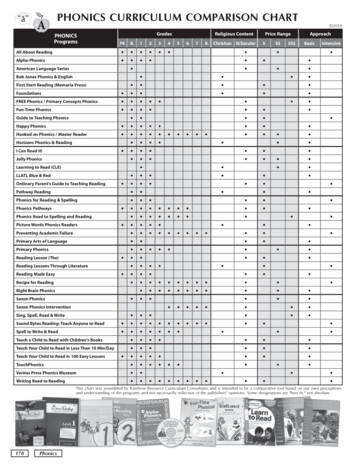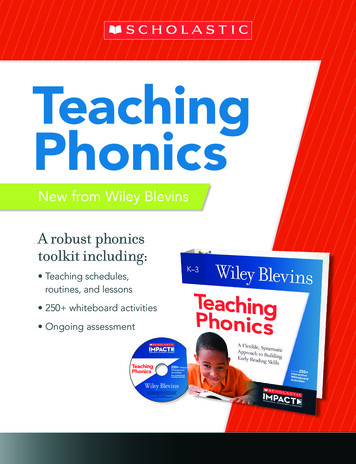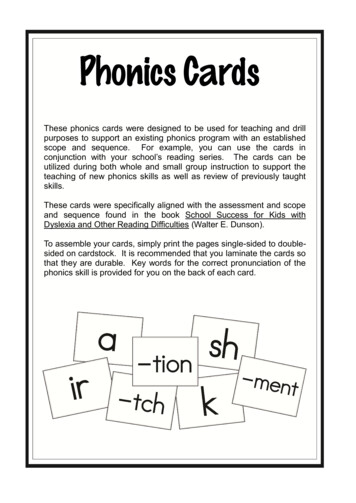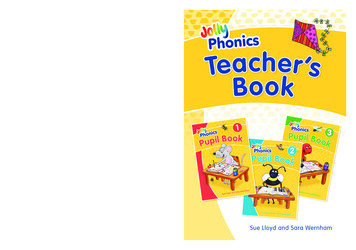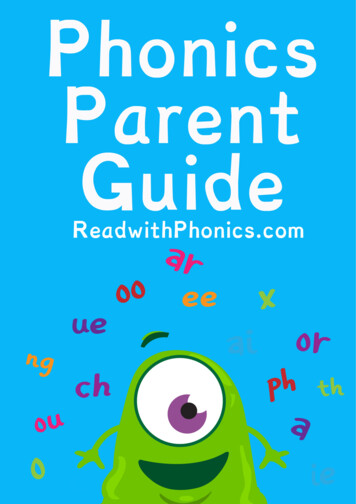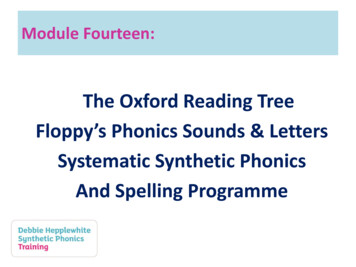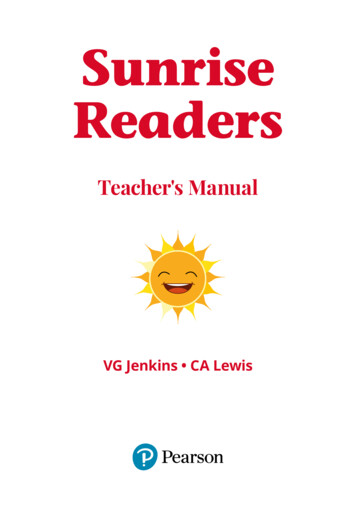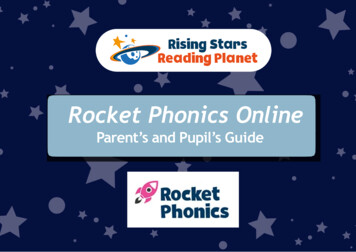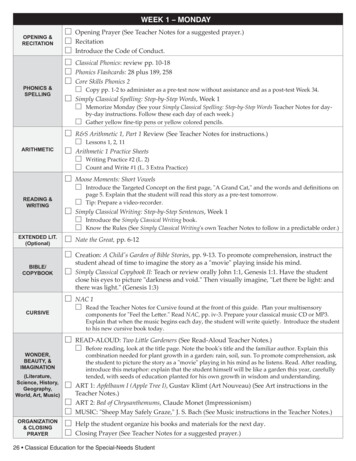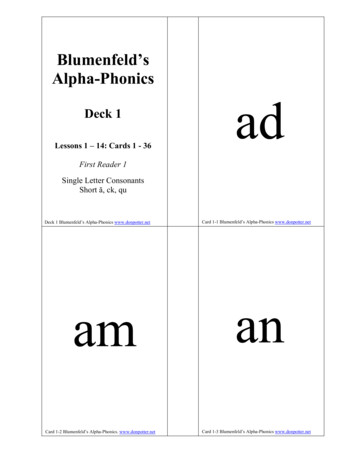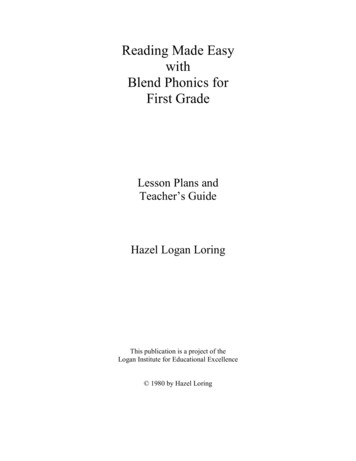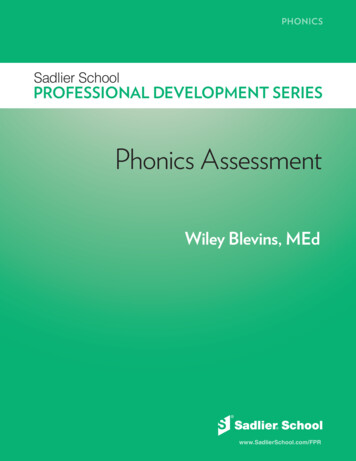
Transcription
PHONICSSadlier SchoolPROFESSIONAL DEVELOPMENT SERIESPhonics AssessmentWiley Blevins, MEdwww.SadlierSchool.com/FPR
TABLE OF CONTENTSWhy Assessment Matters . . . . . . . . . . . . . . . . . . . . . . . . . . . . . . . . . . . . . . . . . . . . . . . . . 3Types of Assessment . . . . . . . . . . . . . . . . . . . . . . . . . . . . . . . . . . . . . . . . . . . . . . . . . . . . . 4Comprehensive Phonics Assessment Survey: Placement . . . . . . . . . . . . . . . . . . . . 4Copyright 2020 by William H. Sadlier, Inc. All rights reserved.Cumulative Phonics Assessment: A Check for Mastery and/orDecayed Learning to Make a Course Corrections . . . . . . . . . . . . . . . . . . . . . . . . . . 5Observations During Reading (including comprehension work) . . . . . . . . . . . . . 6Analysis of Student Writing . . . . . . . . . . . . . . . . . . . . . . . . . . . . . . . . . . . . . . . . . . . . . . . 8Assessing Other Foundational Skills . . . . . . . . . . . . . . . . . . . . . . . . . . . . . . . . . . . . . . . . 9About the Author . . . . . . . . . . . . . . . . . . . . . . . . . . . . . . . . . . . . . . . . . . . . . . . . . . . . . . .12References . . . . . . . . . . . . . . . . . . . . . . . . . . . . . . . . . . . . . . . . . . . . . . . . . . . . . . . . . . . . .12
WHY ASSESSMENT MATTERSWHY ASSESSMENT MATTERSWe often hear the phrase “assessment drives instruction.” Yet, many assessmentsstudents take have limited effect on the instruction they receive because eitherthe assessment results don’t arrive in a timely fashion, they are not granularenough for you to use the assessment data, or you don’t have the “next steps”information and resources to impact learning. So, what kinds of assessmentsare needed for effective phonics instruction and how can they be used?Copyright 2020 by William H. Sadlier, Inc. All rights reserved.To get a full picture of a student’s growing foundational skills (including phonics),multiple tools must be used. These include a comprehensive assessment,frequently administered cumulative assessments, observations made duringthe student’s reading, and periodic assessment of the student’s writing.In addition, looking at a student’s foundational skills growth, such as phonics,requires evaluation through two critical lenses: accuracy and automaticity. Forexample, accuracy tells us correctness in reading words with specific phonicsskills. Automaticity tells us mastery of these skills. Why is this so important?Imagine two students taking a letter recognition assessment. Both studentsmight be able to complete this assessment with 100% accuracy. If you onlylooked at the accuracy scores, you might proceed with your instruction forboth students in the same manner. However, if one student completed theassessment in 30 seconds with 100% accuracyand the other completed the assessment in3 minutes with 100% accuracy, then thenext steps instructionally would bequite different for these two students.Automaticity in recognizing theseletters provides valuable informationabout mastery. Monitoring mastery orits opposite (decayed learning) after theinitial instruction on a target skill is anessential, but often missed, componentof phonics and other foundational skillassessment.Sadlier School Professional Development Series Phonics Assessment3
TYPES OF ASSESSMENTSTYPES OF ASSESSMENTSLet’s look at the four major ways in which a student’s phonicsmastery must be evaluated.Comprehensive Phonics Assessment Survey:PlacementCopyright 2020 by William H. Sadlier, Inc. All rights reserved.A comprehensive phonics assessment covers a span of skills (across multiplegrades) from simple to complex and is a great tool to determine thefoundational skill needs of students as they progress through the grades. Inorder to build a strong reading foundation, we must assess students at eachgrade to see if there are any skill “holes”in terms of phonics. Then, we can providetargeted instruction to fill those phonics“holes” to strengthen the reading foundation.Below is an example of a comprehensivephonics assessment in From Phonics toReading . The skills are organized by type orcategory of learning, such as short vowels,long vowels, and so on to give you an easyand precise starting point for instructionwhen rebuilding a student’s phonicsfoundation.From Phonics to ReadingSadlier School Professional Development Series Phonics Assessment4
TYPES OF ASSESSMENTSCumulative Phonics Assessment:A Check for Mastery and/or Decayed Learningto Make Course CorrectionsCopyright 2020 by William H. Sadlier, Inc. All rights reserved.Assessment of phonics skills must be done over an extended period of timeto ensure mastery. Weekly assessments focusing on one skill often give “falsepositives.” That is, they show movement toward learning, but not mastery. Ifthe skill isn’t worked on for subsequent weeks, learning can decay. Cumulativephonics assessments help you determine which skills have truly beenmastered and are now being transferred to new reading situations. Cumulativeassessments monitor mastery and/or decayed learning in real time. They are acritical phonics instructional tool and fluency check.Below are examples of cumulative phonics assessments in From Phonics toReading. The student is assessed on the week’s skill, as well as on skills fromthe previous five weeks. You assess a few students each week, cycling throughstudents every 3–4 weeks. (Assessing all students each week is too timeconsuming and not necessary for this assessment.) Then, the assessments arelooked at over a span of time. For example, you can trace the Week 1 phonicsFrom Phonics to Reading, Grade 1Sadlier School Professional Development Series Phonics Assessment5
TYPES OF ASSESSMENTSskills across three assessments. This allows you to monitor changes in accuracy(increased checks indicate accuracy, decreased checks indicate decayedlearning) and automaticity (increased checks over time indicate mastery/fluency). This provides you with the information needed to make immediatecourse corrections and meet class and individual student needs beforeinstructional issues become too big.Observations During Reading(including comprehension work)Listening to a student read is certainly one of the best indicators of a student’sgrowing mastery of phonics skills. Periodically keep records of student errors whilereading. Jot down words they struggle with. Examine the list and ask yourself:Copyright 2020 by William H. Sadlier, Inc. All rights reserved. Are there specific previously taught phonics skills that aren’t beingconsistently applied? Is the student struggling with high-frequency words that haveirregular spelling patterns? Are there too many words in the story with skills the student hasn’tbeen taught?The answers to these and otherquestions can inform your nextsteps. So, for example: If the student strugglesreading words withpreviously taught phonicsskills, continue to add andreinforce these skills duringblending, dictation, andword-building exercises.Engage the student in moretargeted practice duringsmall-group lessons andread (and reread) additionaldecodable texts. If the student struggleswith high-frequencySadlier School Professional Development Series Phonics Assessment6
TYPES OF ASSESSMENTSCopyright 2020 by William H. Sadlier, Inc. All rights reserved.words that contain irregular spelling patterns, continue to reviewthese words using the Read/Spell/Write routine. During the Readportion of the routine, make sure that you guide the student in orallysegmenting the word. Then point out the known sound-spellingsof the word to highlight the part of the word the student needs tomemorize. For example, “Let’s tap the sounds in the word said: /s/ /e//d/. How many sounds do you hear? Let’s look at how said is spelled.You already know some of these spellings. The letter s stands forthe /s/ sound at the beginning of said. The letter d stands for the /d/sound at the end of said. What’s left? The letters ai in the middle standfor the /e/ sound in this word. These are the letters we will need toremember when spelling the word said.” If the text contains too many words with phonics skills the studenthasn’t learned, use more controlleddecodable text to help build mastery oftaught skills and increase the student’sconfidence in reading. Confidencebuilds joy in reading. Struggle andfailure can lead to a dislike or avoidanceof reading. The texts early readers readcan greatly influence how they feelabout reading and their ability to tacklenew texts.In addition to listening to students read, itis critical that students recognize that allreading is about understanding. Pay closeattention to the questions provided with thedecodable stories. They range from simplerecall to higher-order thinking questions.These questions require students to rereadthe text and support their answers withevidence. These questions provide valuableinformation regarding how students areprocessing the text and their level ofcomprehension. The follow-up writing to thedecodable stories further deepens students’comprehension as they are required to rereadthe story and share in writing their growingunderstanding of the key ideas or storyline.Sadlier School Professional Development Series Phonics AssessmentFrom Phonics to Reading, Grade 17
ANALYSIS OF STUDENT WRITINGANALYSIS OF STUDENT WRITINGWriting is one of the most valuable and underused tools to evaluate astudent’s growing mastery of phonics skills. Writing lags behind reading forour early learners. So, students will learn phonics skills and will generallymaster them faster than they can consistently apply them in writing. Usingthis understanding, if you notice a student consistently using a phonics skill inwriting, such as final -e (words with a e, for example), then you know that thisstudent can read these words in connected text.Copyright 2020 by William H. Sadlier, Inc. All rights reserved.Activities such as dictation (guided spelling) and word building help toaccelerate students’ use of previously taught phonics skills in writing. Theyfocus students’ attention on these new phonics patterns. Writing aboutthe decodable readers as a follow-up provides students with targetedopportunities to apply the newly taught skills. For students needing extrasupport, they can refer to the decodable story. The more targeted writingexperiences students have during phonics lessons, the greater the likelihoodthey will accurately and consistently apply these skills to express ideas andinformation learned when writing.So, what can you do? Periodically (e.g., once a month) collect samplesof a student’s recent writing. These can includefollow-up writing to the decodable readers, freewriting in their writing journals, and writingassignments during your standard writingcurriculum. Create a checklist of the phonics skills youhave taught up to that point. Scan the writingsamples for consistent and accurate use ofthose phonics skills. Circle those that are consistently and accuratelyused. Place a check mark beside those needingadditional instruction and practice. Use your findings to modify whole-classdictation exercises (if you observe somecommon issues) or form small groups basedon specific needs and offer more dictation andword-building practice using these skills.Sadlier School Professional Development Series Phonics Assessment8
ASSESSING OTHER FOUNDATIONAL SKILLSASSESSING OTHERFOUNDATIONAL SKILLSCopyright 2020 by William H. Sadlier, Inc. All rights reserved.Phonics isn’t the only foundational skill that needs to be assessed for ourearly readers and writers. Most state standards include other skills such asphonological awareness, concepts of print (e.g., reading left-to-right and topto-bottom, understanding words are separated by spaces), and fluency. Thesealso need to be frequently monitored.Concepts of Print: Reading from left-to-right and top-to-bottom andunderstanding that words are separated by spaces in text are fairlysimple concepts for students to grasp and are acquired easily whenfrequently modeled in early reading and writing instruction. Observationis the best way to assess a student’sunderstanding of these basic conceptsof print. For example, ask a student totrack the print (point to each word)while reading. Model as needed if thestudent struggles. Reinforce spacingbetween words while writing andmodel during shared and interactivewriting exercises.Phonological Awareness: In orderto read and write, students mustunderstand that words are comprisedof discrete sounds and be able toblend, segment, and manipulate thosesounds. Blending and segmenting area focus of early reading and writinginstruction because they are so tightlyconnected to beginning readingand writing growth. For example, if astudent cannot orally blend sounds tomake a word, they will not be able tosound out a word while reading text.Likewise, if a student cannot orallysegment the sounds in a word, thestudent will struggle writing wordsSadlier School Professional Development Series Phonics AssessmentFrom Phonics to Reading9
ASSESSING OTHER FOUNDATIONAL SKILLSbecause beginning writers think about thesounds in words and attach a letter or spelling toeach sound in order to write it.Copyright 2020 by William H. Sadlier, Inc. All rights reserved.As students progress in their skills, phonemicmanipulation tasks (phoneme substitution,deletion, addition) play a crucial role. These skillscontinue to develop in students past Grade 1where most state standards end the instructionin phonemic awareness and are connected to astudent’s ability to remember words (througha process called orthographic mapping). Thatis why it is so critical to assess these skills inKindergarten and Grade 1 for all students andcontinue that assessment in Grades 2 and 3 forstudents who may be struggling to see if theseunderlying skills are an issue.You will find a battery of phonological awarenessassessments and a schedule of assessing in FromPhonics to Reading. Below are some samples.From Phonics to ReadingFluency: Phonics fluency needs to be assessed atthe letter, word, and sentence level.Letter Fluency: Letter fluency needs to be assessed in Kindergarten.Use your district-created letter assessment or create one by writing theletters in random order. Blevins (2016) suggests a letter naming andletter sound assessment sequence based on current research (Phillipset al, 2012; Piasta et al, 2014) that places the letters in a sequencefrom easier to more complex. When assessing letter names, put acheckmark next to the letter if named correctly and circle it if it is namedautomatically (without any pause). Repeat for letter sounds.Word Fluency: The Cumulative Assessment at the end of each week(described in an earlier section) in From Phonics to Reading offers thebest word reading fluency check. The frequency of these checks andtheir cumulative nature allow you to quickly determine mastery versusdecayed learning so that instructional modifications can be made beforebigger reading issues develop.Sadlier School Professional Development Series Phonics Assessment10
ASSESSING OTHER FOUNDATIONAL SKILLSSentence Fluency: Listening to students read is the ideal way to assessreading fluency at the sentence level. Grade-level reading rates areavailable from Tindal and Hasbrouck (2017) based on one-minute reads.These can be used to determine which students are reading at ratesbelow-, on-, or above-level. While most schools have existing readingfluency passages for assessment, you can create your own using gradelevel texts students haven’t read. These “cold” reads should reflectgrade-level phonics standards in terms of coverage and be both fictionand informational. You can also use previously read decodable texts inFrom Phonics to Reading as “warm” reads with a higher expectation foraccuracy and automaticity.Copyright 2020 by William H. Sadlier, Inc. All rights reserved.The frequent and varied assessments available in From Phonics to Readingcan provide you the essential information you need to monitor students’foundational skills growth in a way that is responsive to each student’s needs.It is through these impactful assessments that we can truly inform instructionto build a strong foundation in early reading and writing.From Phonics to ReadingSadlier School Professional Development Series Phonics Assessment11
ABOUT THE AUTHORWiley Blevins is the author of Sadlier’s new From Phonics to Reading forGrades K–3.This program is a comprehensive foundational skills program thatincorporates Seven Key Characteristics of Strong Phonics Instruction.Embedded professional development along with a critical review andrepetition cycle make early reading mastery possible for every student.Wiley Blevinswbny@aol.comCopyright 2020 by William H. Sadlier, Inc. All rights reserved.Wiley Blevins has taught elementary school in both the United States andSouth America. A graduate of Harvard Graduate School of Education, hehas written over 15 books for teachers (including Phonics from A to Z,A Fresh Look at Phonics, Building Fluency, and Teaching Nonfiction),authored elementary reading programs, conducted research on topicsranging from fluency to using decodable text, and regularly trainsteachers throughout the United States and Asia.His current interests include using adaptive technology and working withdistricts to correct instructional and material deficits. Wiley lives in NewYork City and also writes children’s books.REFERENCESBlevins, W. (2016). A fresh look at phonics: Common causes of failureand 7 ingredients for success. Thousand Oaks, CA: Corwin.Hasbrouck, J. & Tindal, G. (2017). An update to compiled ORF norms(Technical Report No. 1702). Eugene, OR, Behavioral Research andTeaching, University of Oregon.(2012). IRTs of the ABCs: Children’s letter name acquisition. Journalof School Psychology, 50(4), 461–481.Piasta, S.B. (2014). Moving to assessment-guided differentiatedinstruction to support young children’s alphabet knowledge. TheReading Teacher, 68(3), 202–211.Phillips, B.M., Piasta, S.B., Anthony, J.L., Lonigan, C.J., & Francis, D.J.Sadlier School Professional Development Series Phonics Assessment12
and Sadlier are registered trademarks of William H. Sadlier, Inc. Copyright 2020 by William H. Sadlier, Inc. All rights reserved.May be reproduced for education use (not commercial use).You might also be interested in:From Phonics to Reading, Gr. k–3www.SadlierSchool.com/FPRPROFESSIONAL DEVELOPMENT SERIESSadlier SchoolA Publication ofwww.SadlierSchool.com
A comprehensive phonics assessment covers a span of skills (across multiple grades) from simple to complex and is a great tool to determine the foundational ski
